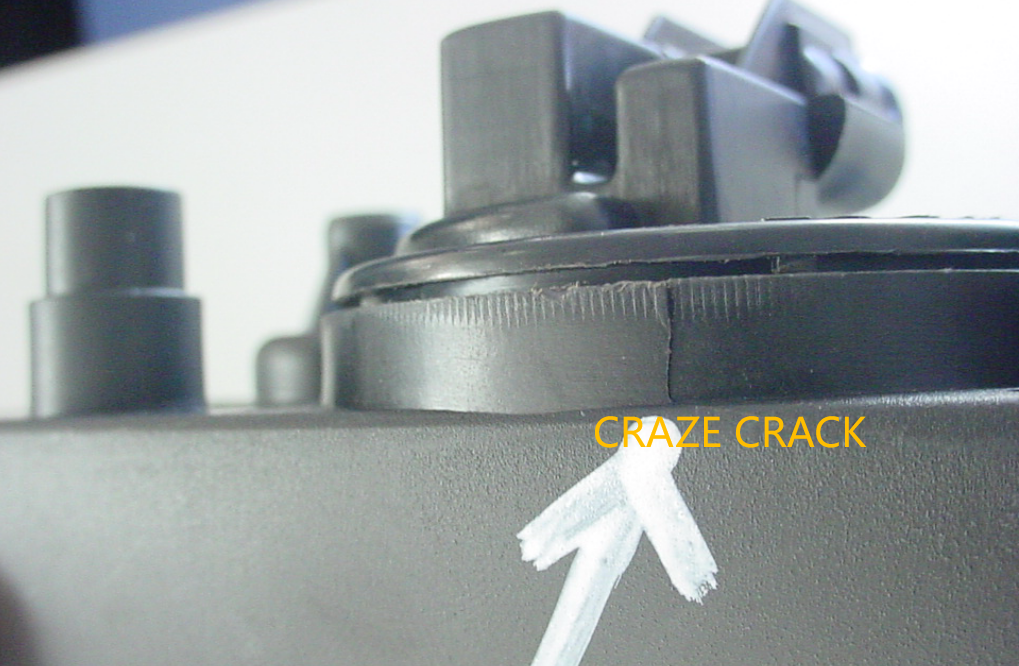Erreur de format d'e-mail
emailCannotEmpty
emailDoesExist
pwdLetterLimtTip
inconsistentPwd
pwdLetterLimtTip
inconsistentPwd

Offer Technical Support and Customized Solutions
The company is committed to creating new and improved plastic materials to meet the evolving demands of the market.

Troubleshooting Cracking and Whitening Issues in Injection Molding Process
Hey there, fellow manufacturers and injection molding enthusiasts! Today, let's delve into the causes and solutions for two common challenges in the injection molding process: cracking and whitening. These issues can result in compromised product quality and even pose safety risks. So, understanding the root causes and tackling them head-on is crucial. Let's explore!
Cracking, which includes surface cracks, micro-cracks, whitening, and dimensional instability caused by sticking or mold flow, can be classified into two types: demolding cracking and application cracking. In demolding cracking, the molded parts fracture during ejection, while application cracking refers to parts that easily break or crack under stress. Now, let's analyze the factors contributing to these challenges:
-
Injection Molding Machine:
- The plasticizing capacity of the injection molding machine should be appropriate. Inadequate plasticization leads to insufficient mixing and brittleness, whereas excessive plasticization can cause degradation.
-
Mold Design:
- Proper balance during ejection is essential, including having a sufficient number of ejector pins with appropriate cross-sectional area, adequate draft angles, and smooth cavity surfaces. This helps prevent the concentration of residual stresses due to external forces, thus reducing the risk of cracking.
- Avoid excessively thin wall thicknesses in the product design. Utilize rounded transitions instead of sharp corners or edges to avoid stress concentration.
- Minimize the use of metallic inserts to prevent differential shrinkage from increasing internal stress.
- Incorporate suitable venting channels for deep-drawn parts to prevent vacuum phenomenon.
- Ensure the main runner is large enough to allow the gate material to solidify before demolding, facilitating easier part removal.
- Properly design the interface between the runner sleeve and the nozzle to prevent cold slug dragging and part sticking to the fixed mold plate.
- Avoid undersized runners and gates, as excessive shear rates during mold filling can result. Use full-round runners and increase the runner and gate dimensions to provide acceptable shear rates during mold filling.
-
Process Parameters:
- Excessive injection pressure, high injection speed, excessive material volume, and prolonged injection and holding times can lead to excessive internal stress and subsequent cracking.
- Adjust the mold opening speed and pressure to prevent rapid and forceful part ejection, which can cause premature demolding cracking.
- Optimize mold temperature to facilitate easier part demolding. Control the cooling rate by limiting the flow of cooling media through the mold. Degrading plastic within the barrel can cause molecular structure breakdown. Stabilize the barrel temperature in all zones, reduce backpressure, and ensure correct temperature settings for exhaust vents.
- Prevent cracking due to degraded mechanical strength caused by melt fracture marks. Suitably adjust the melt temperature and injection speed.
- Adequately use mold release agents and regularly remove any air or mist adhering to the mold surface.
- Residual stresses in the part can be relieved by performing post-molding annealing, thereby minimizing crack formation.
- If the melt temperature is too low, increase the temperature in the feed zone and nozzle of the injection cylinder and reduce the screw speed or use high-speed conversion to achieve the correct screw surface speed.
- Slow mold filling speed can lead to inadequate part packing. Increase the injection speed and maintain consistent cushioning on the injection machine.
-
Material Selection:
- Avoid using a high percentage of recycled materials as it can reduce the strength properties of the molded parts. Minimize the amount of recycled material mixed with fresh plastic.
- Excessive humidity can cause chemical reactions between certain plastics and water vapor, leading to reduced strength and demolding cracking.
- Ensure that the material is suitable for the processing environment and of good quality. Contamination and the presence of foreign plastic impurities can cause cracking. Regularly inspect the plastic feedstock for impurities and thoroughly clean the feed hopper or material loader.
By paying close attention to these factors and implementing appropriate solutions, you can effectively minimize cracking and whitening issues in the injection molding process. Remember, an optimized process, well-designed molds, suitable materials, and careful parameter adjustments are key to achieving high-quality, defect-free molded products.
That's all for now, folks! Feel free to reach out if you have any further questions or want more insights. Keep molding and keep smiling!

